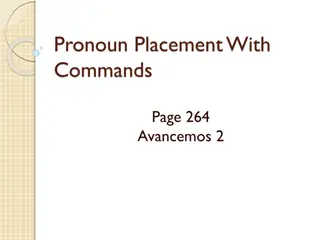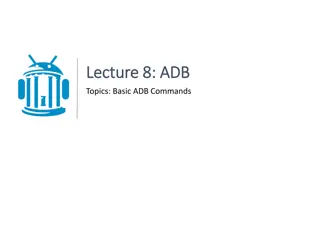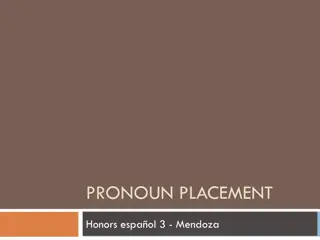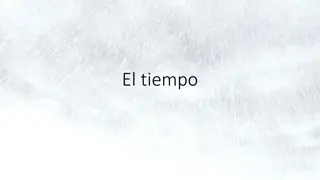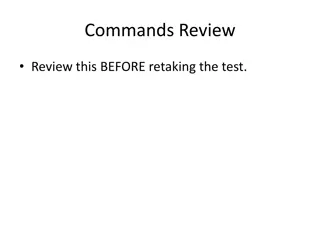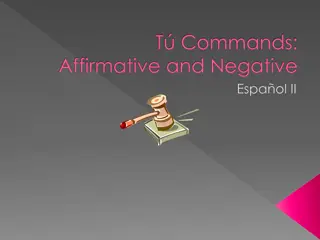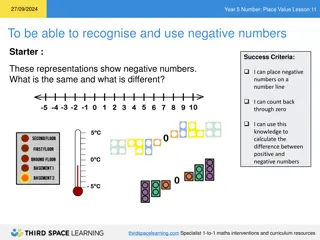Understanding Negative -T Commands in Spanish
Negative -T commands in Spanish are used to tell someone what not to do. These commands are often directed at friends or familiar individuals. Forming negative -T commands involves starting with the YO form in the present tense, dropping the O for -ER/-IR verbs, adding -ES for -AR verbs, and including NO at the beginning. Verbs with irregular YO forms follow similar rules. Examples and images further illustrate how to create and use negative -T commands effectively.
Download Presentation

Please find below an Image/Link to download the presentation.
The content on the website is provided AS IS for your information and personal use only. It may not be sold, licensed, or shared on other websites without obtaining consent from the author. Download presentation by click this link. If you encounter any issues during the download, it is possible that the publisher has removed the file from their server.
E N D
Presentation Transcript
Negative t commands Cap tulo 7A-Realidades 2 p. 356
What are Negative t commands? They are used to tell someone what NOT to do and that someone is usually a friend or someone we are familiar with.
How do we form a negative t command? There are 3 easy steps: 1. Start with the YO form present tense. 2. Drop the O . -ER/-IR verb and don t forget the NO!!! 3. Add es for an AR verb and add as for an
For example: 1. A adir=A ado 2. A ad- 3. NO a adas No a adas sal porque es malo para la salud.
Another normal verb: 1. Hablar=Hablo 2. Habl- 3. No hables No hables ingl s en la clase de espa ol
Lets try one more: 1. Comer=Como 2. Com- 3. No comas No comas en esta clase!
What about verbs with an irregular YO form? You will follow the same rules for the normal verbs. For example: 1.Tener=Tengo 2.Drop the O =Teng- 3.Add the new ending=Tengas and don t forget the NO NO TENGAS
Yo-Go verbs Decir
Yo-Go verbs Digo
Yo-Go verbs Dig-
Yo-Go verbs NO digas
Yo-Go verbs Poner
Yo-Go verbs Pongo
Yo-Go verbs Pong-
Yo-Go verbs NO pongas
Yo-Go verbs Hacer
Yo-Go verbs Hago
Yo-Go verbs Hag-
Yo-Go verbs NO hagas
Yo-Go verbs (3 steps) Salir
Yo-Go verbs Salgo
Yo-Go verbs No salgas
Yo-Go verbs No vengas
Yo-Go verbs O r
Yo-Go verbs No oigas
Yo-Go verbs Caer
Yo-Go verbs No caigas
Yo-Go verbs Tener
Yo-Go verbs No tengas
What about boot verbs? You will still follow the same rule!! 1. Encender=Enciendo 2. Drop the O =Enciend- 3. Add the ending and the NO NO Enciendas
Boot Verbs (1 paso) Servir
Boot Verbs No sirvas
Boot Verbs Pensar
Boot Verbs No pienses
Boot Verbs Repetir
Boot Verbs No repitas
Boot Verbs Querer
Boot Verbs No quieras
Verbs that end in car, -gar y - zar The same rule again!!! But this time there will be some spelling changes, just like what we saw in the Preterite: 1. Jugar=Juego 2. Jueg- 3. NO JuegUES 1. Picar=Pico 1.Empezar-empiezo 2. Pic- 3. NO piQUES 2. Empiez- 3. NO empieces
Verbs that end in car, -gar y zar Almorzar Yo form=Almuerzo
Verbs that end in car, -gar y zar Almorzar Negative t =No almuerces
Verbs that end in car, -gar y zar Comenzar Yo form=Comienzo
Verbs that end in car, -gar y zar Comenzar Negative t =No comiences
Verbs that end in car, -gar y zar Picar Yo=pico
Verbs that end in car, -gar y zar Picar Negative t =No piques
Verbs that end in car, -gar y zar Pagar Yo=pago
Verbs that end in car, -gar y zar Pagar Negative t =No pagues
One last thingI swear The next list is a song that shows all of the verbs that do not follow the 3 step rule.
hayas vayas seas sepas **tengas** est s des




